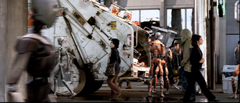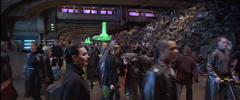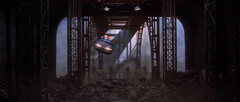 |
The
movies speculate that waste will become even more prominent an issue in
future urban environments. The waste management strategy employed in I-Robot,
periodic street collection, is very similar to that used today except that
it is conducted by robots. This system seems to suffice for an urban environment
similar in size to those currently in existence. Much denser urban environments
must employ new strategies or else major overflow will occur. The New York
presented in The Fifth Element, which has much larger densities as a result
of its taller towers, has had difficulty dealing with its waste. The overflow
of waste has become so extensive that it has infiltrated major public spaces,
such as the spaceport presented, and has actually rendered the ground plane
uninhabitable, strictly a space for backlogged garbage. The necessity of
waste management is recognized in the 2001 version of Metropolis. The urban
environment envisioned has devoted an entire subterranean level to waste
management. In addition, the extensive fleet of garbage collecting robots
is stressed. Waste
is something people inherently dislike because it has no use and it pollutes
in many ways. It is managed in a very efficient way to minimize the interaction
with it. Any environment that is cluttered with waste will create discomfort.
An urban environment that has its former public domain covered in trash
is an extremely uncomfortable speculation in itself but also in its connotations
of disorder in that society.
|

(I-Robot/2004)


(The Fifth Element/1997)

|
|










